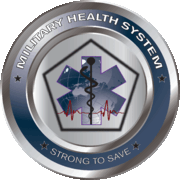- Military Health System
-
Military Health System 
Agency overview Headquarters Washington, DC Employees 137,000 Annual budget $42 billion Agency executive Dr. Charles Rice, Performing the Duties of the Assistant Secretary of Defense for Health Affairs Website www.health.mil The Military Health System is the enterprise within the United States Department of Defense responsible for providing health care to active duty and retired U.S. Military personnel and their dependents.[1] The mission of the Military Health System (MHS) is to provide health support for the full range of military operations and sustain the health of all who are entrusted to MHS care.[2]
The primary mission of the medical services system is to maintain the health of military personnel, so they can carry out their military missions, and to be prepared to deliver health care required during wartime. Often described as the medical readiness mission, this effort involves medical testing and screening of recruits, emergency medical treatment of servicemen and women involved in hostilities, and the maintenance of physical standards of those in the armed services. In support of those in uniform, the military medical system also provides, where space is available, health care services to dependents of active duty service members. Space available care is also provided to retirees and their dependents. Some former spouses are also included. Since 1966 civilian medical care for dependents of active duty personnel, and for retirees and their dependents who are under age 65 has been available (with certain limitations and co-payments) through the Civilian Health and Medical Program of the Uniformed Services (CHAMPUS) and its successor, TRICARE. Since October 2001 TRICARE benefits have also been available to retirees and their dependents aged 65 and over.[1]
The MHS executes a $42 billion budget and serves approximately 9.5 million beneficiaries, including Active Duty personnel and their families and retirees and their families.The actual cost of having a government run health care system for the military is higher [be]cause the wages and benefits paid for military personnel who work for the MHS and the retirees who formerly worked for it, is not included in the budget. MHS employs more than 137,000 personnel in 65 hospitals, 412 clinics, and 414 dental clinics at facilities across the nation and around the world, as well as in contingency and combat-theater operations worldwide.
Contents
History
Prior to the Civil War, medical care in the military was provided largely as a function of the regimental surgeon and surgeons mates. While further attempts were made to establish a centralized medical system, care provision was largely local and limited. The availability of effective treatment for disease and injury was, by modern standards, primitive. Significant changes began to occur near the time of the Civil War, when improvements in medical science, communications and transportation made centralized casualty collection and treatment more practical.
In World War I the U.S. Army Medical Department expanded and developed greater organization and structure. Care began on the battlefield and was then transferred to successively greater levels of medical capability. Considerable medical service capability was located in the combat theater. This capability was to ensure the availability of needed care, and to help maintain combat unit strength by returning soldiers to duty if their condition could be effectively treated in theater. Expansion continued during World War II under the necessity to meet changing needs of the war, but without the benefit of an organizational or expansion plan.
After World War II, the Executive Branch of the U.S. Government underwent significant reorganization. The separate Department of War and Department of the Navy were re-aligned under a single Department of Defense. The reorganization created conflict as the Army had evolved its own medical system, as had the Navy. Furthermore, the Air Force, originally part of the Army, was created as a separate military service with its own separate Medical Service.
Changes in the perception of health care in the post World War II era and an assessment of medical services provided to dependents caused Congress to re-evaluate the dependent health care benefit in the late 1950s. At that point changes in tax law had induced business and industry to begin offering a health care benefit as an employment incentive. A 1956 Department of Defense estimate was that 40 percent of active duty dependents did not have access to federal facilities due to distance, incomplete medical coverage at the federal facility, or due to the saturation of services at military treatment facilities. Congress responded by passing the Dependents Medical Care Act of 1956 and the Military Medical Benefits Amendments of 1966. These acts created the program known as the Civilian Health and Medical Program of the Uniformed Services (CHAMPUS).[3]
In the late 1980s, because of escalating costs, claims paperwork demands and general beneficiary dissatisfaction, DOD initiated a series of demonstration projects. Under a program known as the CHAMPUS Reform Initiative (CRI), a contractor provided both health care and administrative-related services, including claims processing. The CRI project was one of the first to introduce managed care features to the CHAMPUS program. Beneficiaries under CRI were offered three choices – a health maintenance organization-like option called CHAMPUS Prime that required enrollment and offered enhanced benefits and low-cost shares, a preferred provider organization-like option called CHAMPUS Extra that required use of network providers in exchange for lower cost shares, and the standard CHAMPUS option that continued the freedom of choice in selecting providers and higher cost shares and deductibles.
Although DOD’s initial intent under CRI was to award three competitively bid contracts covering six states, only one bid, made by Foundation Health Corporation (now Health Net) covering California and Hawaii, was received. Foundation delivered services under this contract between August 1988 and January 1994.
In late 1993, in response to requirements in the DOD Appropriation Act for Fiscal Year 1994, the DOD announced plans for implementing a nationwide managed care program for the MHS that would be completely implemented by May 1997. Under this program, known as TRICARE, the United States would be divided into 12 health care regions. An administrative organization, the lead agent, was designated for each region and coordinated the health care needs of all military treatment facilities in the region. Under TRICARE, seven managed care support contracts were awarded covering DOD’s 12 health care regions.[4]
Since then, TRICARE has undergone several restructuring initiatives, including re-alignment of contract regions, Base Realignment and Closure, and the addition of "TRICARE for Life" benefits in 2001 for those who are Medicare-eligible, and "TRICARE Reserve Select" in 2005.
Components
Led by the Office of the Assistant Secretary of Defense for Health Affairs, the Military Health System includes several core organizational areas including:
- TRICARE/TRICARE Management Activity (TMA)
- Force Health Protection and Readiness (FHP&R)
- Uniformed Services University of the Health Sciences (USU)
- Defense Centers of Excellence for Psychological Health and Traumatic Brain Injury (DCOE)
- Office of the Chief Information Officer (MHS-OCIO)
The MHS also includes the medical departments of the Army, Navy, Marine Corps, Air Force, Coast Guard, and Joint Chiefs of Staff; the Combatant Command surgeons; and TRICARE providers (including private sector healthcare providers, hospitals and pharmacies).
Facilities
See Category:United States military medical facilities.
See also
- Assistant Secretary of Defense for Health Affairs
- Military medicine
- Surgeon General of the United States Army
- Surgeon General of the United States Navy
- Surgeon General of the United States Air Force
- TRICARE
- http://en.wikipedia.org/wiki/Uniformed_Services_University_of_the_Health_Sciences
- US Family Health Plan
References
 This article incorporates public domain material from the United States Government document "Task Force on the Future of Military Health Care: Final Report".
This article incorporates public domain material from the United States Government document "Task Force on the Future of Military Health Care: Final Report". This article incorporates public domain material from the United States Government document "Military Medical Care Services: Questions and Answers".
This article incorporates public domain material from the United States Government document "Military Medical Care Services: Questions and Answers". This article incorporates public domain material from the United States Government document "Unification of the Military Health System: A Half-Century Unresolved Debate".
This article incorporates public domain material from the United States Government document "Unification of the Military Health System: A Half-Century Unresolved Debate". This article incorporates public domain material from the United States Government document "Defense Health Care: Despite TRICARE Procurement Improvements, Problems Remain".
This article incorporates public domain material from the United States Government document "Defense Health Care: Despite TRICARE Procurement Improvements, Problems Remain".- ^ a b Best, Jr., Richard A. (2005-05-05). "Military Medical Care Services: Questions and Answers" (pdf). Congressional Research Service. http://www.fas.org/sgp/crs/misc/IB93103.pdf. Retrieved 2008-05-23.
- ^ "Task Force on the Future of Military Health Care: Final Report" (pdf). United States Department of Defense. 2007-12-20. http://www.dodfuturehealthcare.net/images/103-06-2-Home-Task_Force_FINAL_REPORT_122007.pdf. Retrieved 2008-05-20.
- ^ Jones, M.D., Col. D. E. Casey (2001-04-10). "Unification of the Military Health System: A Half-Century Unresolved Debate" (pdf). Strategic Research Project, U.S. Army War College. http://stinet.dtic.mil/cgi-bin/GetTRDoc?AD=ADA392242&Location=U2&doc=GetTRDoc.pdf. Retrieved 2008-05-23.
- ^ "Defense Health Care: Despite TRICARE Procurement Improvements, Problems Remain" (pdf). United States General Accounting Office. 1995-08-03. http://www.gao.gov/archive/1995/he95142.pdf. Retrieved 2008-05-26.
External links
- Military Health System
- TRICARE/TRICARE Management Activity (TMA)
- Force Health Protection and Readiness (FHP&R)
- Uniformed Services University for the Health Sciences (USU)
- Defense Centers of Excellence for Psychological Health and Traumatic Brain Injury (DCOE)
- Office of the Chief Information Officer (MHS-OCIO)
Agencies under the United States Department of Defense Deputy Secretary of Defense 
Under Secretary of Defense
for Acquisition, Technology and LogisticsDirector, Defense Research and Engineering · Defense Advanced Research Projects Agency · Missile Defense Agency · Defense Contract Management Agency · Defense Logistics Agency · Defense Technical Information Center · Defense Threat Reduction Agency · Office of Economic Adjustment · Defense Acquisition University · Business Transformation AgencyUnder Secretary of Defense for Policy Under Secretary of Defense (Comptroller) Under Secretary of Defense
for Personnel and ReadinessDefense Commissary Agency · Department of Defense Education Activity · DoD Human Resources Activity · Military Health System · Uniformed Services University of the Health Sciences · Defense Equal Opportunity Management Institute · Office of the Chancellor for Education and Professional DevelopmentUnder Secretary of Defense
for IntelligenceService Departments Categories:- Military medical organizations of the United States
- Healthcare in the United States
- United States Department of Defense
Wikimedia Foundation. 2010.

